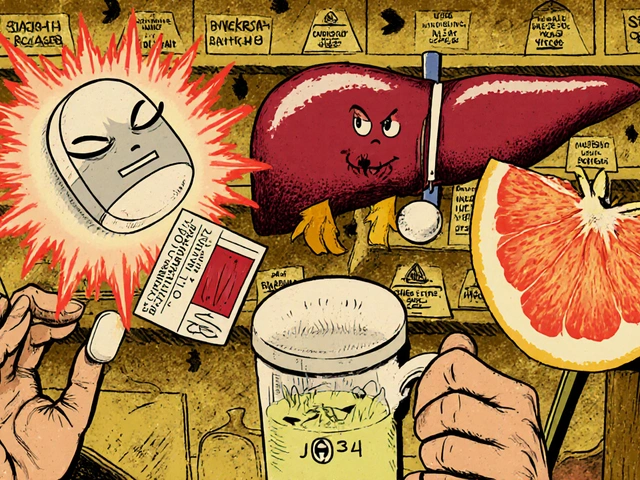When medications stop working for inflammatory bowel disease (IBD), surgery isn’t a failure-it’s often the best path back to a normal life. For many people with Crohn’s disease or ulcerative colitis, surgery means finally sleeping through the night, not racing to the bathroom, or seeing blood in the stool every day. But what does IBD surgery actually involve? And what happens after the operating room doors close?
What Surgery Looks Like for IBD
IBD surgery isn’t one single procedure. It’s tailored to your disease, where it’s active, and what your body can handle. The two main types are resection and ostomy, sometimes used together.For Crohn’s disease, surgeons often do a segmental resection. That means cutting out the damaged piece of bowel-usually the end of the small intestine (ileum) where Crohn’s likes to strike-and reconnecting the healthy ends. It’s like replacing a rusted section of pipe. About 60-70% of patients stay in remission for five years after this, but the disease can come back. That’s why maintenance meds are still needed.
For ulcerative colitis, the goal is to remove the entire colon and rectum. That’s called a proctocolectomy. Unlike Crohn’s, which can pop up anywhere, ulcerative colitis only affects the colon. Remove it, and the disease is gone. That’s why many people with UC choose this route-it’s the only true cure.
When the colon and rectum are removed, the surgeon has to create a new way for waste to leave the body. That’s where ostomies come in.
Ostomy: Temporary or Permanent?
An ostomy is a surgically made opening in the abdomen that connects to the bowel. Waste exits through this opening into a bag worn outside the body. There are two main types used in IBD surgery: ileostomy and colostomy. In IBD, it’s almost always an ileostomy because the colon is removed.Some ostomies are temporary. Others are permanent. The difference comes down to whether the surgeon can reconnect the bowel to the anus.
For ulcerative colitis, many patients get a J-pouch, also called an ileal pouch-anal anastomosis (IPAA). This is when the surgeon takes the last 8-10 centimeters of the small intestine and shapes it into a small pouch, like a little reservoir. Then they sew it directly to the anus. This lets you pass stool normally again-no external bag needed. But it’s not simple. Most J-pouches are built in two or three stages. First, the colon is removed and a temporary ileostomy is created. After 8-12 weeks, the pouch is made and connected. Then, after another few weeks of healing, the temporary ileostomy is reversed.
But not everyone is a candidate for a J-pouch. If your anal sphincter is weak, if you’re over 70, or if you have Crohn’s disease (even if it’s only in the colon), a J-pouch isn’t safe. The risk of the pouch failing or getting inflamed is too high. In those cases, a permanent end ileostomy is the better choice.
A permanent ileostomy means the end of the small intestine is brought out through the abdominal wall. Waste flows continuously into a bag. It sounds scary, but many people who have had one say it’s the best thing that ever happened to them. No more cramps. No more urgency. No more bathroom anxiety.
Postoperative Care: The Real Work Begins After Surgery
The surgery is just the start. The real challenge is recovery-and learning how to live with your new body.After any IBD surgery, you’ll spend 5 to 7 days in the hospital. You’ll be on IV fluids, then slowly move to clear liquids, then soft foods. Pain is managed, but doctors are careful with opioids. Studies show IBD patients are 22% more likely to become dependent on pain meds after abdominal surgery than other patients. So non-opioid options like acetaminophen and nerve blocks are preferred.
If you have a temporary ileostomy, you’ll be taught how to care for it by a certified wound, ostomy, and continence nurse (WOCN). These nurses are specialists. They show you how to measure your stoma, change the bag, prevent skin irritation, and recognize signs of infection. The stoma is about the size of a quarter, sticks out 1-2 cm, and produces 4-6 bowel movements a day. You’ll need to empty the bag often, especially in the first few weeks.
If you have a J-pouch, the learning curve is steeper. In the first 3 months, you might have 6 to 10 bowel movements a day. That drops to 4 to 8 after 6 to 12 months. You’ll need to drink 8 to 10 cups of water daily. Too little, and you risk dehydration. Too much, and you’ll feel bloated. You’ll also need to avoid high-fiber foods like raw vegetables, nuts, and popcorn at first-they can block the pouch.
One of the biggest surprises? Pouchitis. About 40% of people with a J-pouch develop inflammation in the pouch. It causes diarrhea, cramps, and urgency. It’s treatable with antibiotics, but some people need them long-term. That’s why regular follow-ups with your IBD specialist are non-negotiable.

What Success Really Looks Like
Success isn’t just about surviving surgery. It’s about living well after.For those with a permanent ileostomy, 85% report being satisfied at the 5-year mark. They say they feel free. No more planning every outing around a bathroom. No more fear of accidents.
For J-pouch patients, satisfaction is high too-78% report better quality of life. But 22% end up needing another surgery because of pouch failure, strictures, or chronic pouchitis. That’s why surgeons don’t push it on everyone. It’s not for the faint of heart.
One patient from Reddit’s r/IBD community wrote: “I had my J-pouch done at 28. I was terrified. Now I’m 35. I’ve traveled to 12 countries. I’ve had kids. I don’t think about it anymore. That’s the goal.”
Another said: “My ostomy saved my life. I didn’t know it could feel this normal.”
What’s New in IBD Surgery
Surgery isn’t standing still. In 2023, the FDA approved the first smart ostomy bag with leak detection sensors. It alerts you if there’s a problem before it becomes messy. That’s a game-changer for people who fear public accidents.Robotic surgery is becoming more common. At Mayo Clinic, robotic-assisted J-pouch surgeries take 20% less time and have 15% fewer complications than traditional laparoscopic ones.
Researchers are also testing microbiome transplants to prevent pouchitis. Early results show a 40% drop in inflammation after one year. And 3D modeling is being used to design custom pouch shapes based on each patient’s anatomy-something that could reduce failure rates in the future.

Who Should Consider Surgery?
You don’t need to wait until you’re in crisis. Surgery is an option if:- Your symptoms aren’t controlled after 8-12 weeks of strong medications (like biologics)
- You’ve had complications like a bowel obstruction, perforation, or severe bleeding
- You have precancerous changes in your colon (dysplasia)
- You’re tired of living with constant pain, fatigue, and bathroom anxiety
There’s no shame in choosing surgery. It’s not giving up. It’s taking control.
Support You Need After Surgery
You won’t do this alone. Connect with:- A certified WOCN before surgery-they’ll help you pick the right supplies and prep mentally
- Online communities like r/IBD or Ileostomates on Reddit
- Support groups from the Crohn’s & Colitis Foundation
- A dietitian who understands IBD post-op needs
Invest in good supplies. A quality ostomy belt (like the Convatec Adapt Mini, around $46) can make all the difference in comfort and confidence. Don’t wait until you’re struggling to find help.
Final Thoughts
IBD surgery isn’t a last resort. It’s a lifeline. Whether it’s a resection, a J-pouch, or a permanent ileostomy, the goal is the same: to give you back your life. The road isn’t easy. There are setbacks, adjustments, and tough days. But for thousands of people, surgery is the day they stopped surviving-and started living.Is IBD surgery dangerous?
All surgery carries risks, but IBD procedures are well-established. The most serious complication is an anastomotic leak, which happens in 5-15% of J-pouch surgeries and can be life-threatening if not caught early. Other risks include infection, bleeding, and blood clots. Temporary ostomies reduce leak risk by letting the new connection heal safely. Choosing a surgeon who specializes in IBD cuts complication rates by up to 35%.
Can you have kids after IBD surgery?
Yes, but with important caveats. Women who have a J-pouch face a higher risk of infertility-rising from 15% to 50-70% after surgery, often due to scar tissue. Men may experience erectile dysfunction in 15-20% of cases. If you plan to have children, talk to your surgeon before surgery. Some patients choose to freeze eggs or sperm beforehand. A permanent ileostomy has no known impact on fertility.
Do you need to take meds after surgery?
For Crohn’s disease, yes. Surgery removes damaged tissue, but it doesn’t cure the disease. Without maintenance therapy, up to 80% of patients see Crohn’s return within 10 years. For ulcerative colitis, if you’ve had a full proctocolectomy with J-pouch or permanent ileostomy, you usually don’t need IBD meds anymore. But some still take low-dose mesalamine to reduce pouchitis risk.
How long does recovery take?
Hospital stay is typically 5-7 days. Full recovery takes 6-12 weeks for physical healing. But adapting to a J-pouch or ostomy takes 6-12 months. You’ll learn your body’s signals, adjust your diet, and find routines that work. Most people feel like themselves again by the one-year mark.
Can you swim or exercise with an ostomy?
Absolutely. Modern ostomy bags are waterproof and stay securely in place during swimming, running, or weightlifting. Many athletes with ostomies compete at high levels. The key is using the right adhesive and belt. Some people wear swimwear with built-in pouch covers for extra confidence. Exercise is encouraged-it helps with healing and prevents complications like blood clots.
What’s the difference between a temporary and permanent ileostomy?
A temporary ileostomy is created to protect a healing connection (like a J-pouch). It’s reversed in 3-12 weeks after the bowel has healed. A permanent ileostomy means the colon and rectum are gone, and the ileostomy is the only way waste leaves the body. There’s no reversal. Temporary ostomies are common in J-pouch surgeries; permanent ones are used when the rectum is removed or when pouch surgery isn’t safe.






Comments
Just had my J-pouch reversal last month-still can’t believe how normal life feels now. No more panic attacks before leaving the house, no more counting bathrooms like currency. I traveled to Bali last week. No bag. No fear. Just me, the ocean, and my stupidly happy self. 😊
Proctocolectomy with IPAA is the gold standard for UC. J-pouch success hinges on mucosal healing, sphincter integrity, and microbiome resilience. Failure rates spike with prior anti-TNF exposure. You need a high-volume IBD center. Period.
So we're just supposed to trust some doctor who's been doing this for 20 years? Nah. I read on a forum that the FDA is hiding the truth about ostomy bags causing cancer. They're all just in the pocket of Convatec. I'm going natural. Raw garlic. No meds. No bags. I'm free.
Surgery isn't about surrender-it's about sovereignty. When your body becomes a battlefield, choosing to remove the occupied territory isn't defeat. It's strategy. The courage it takes to walk into that OR, knowing you might never be the same-but choosing to be better-is one of the most profound acts of self-respect I've ever seen. You're not broken. You're being rebuilt.
For anyone considering surgery: find a WOCN before your first consult. They’ll teach you how to talk to your family, pick supplies that don’t leak, and help you visualize life after. This isn’t just medical-it’s emotional engineering. You’re not losing something. You’re gaining back your autonomy. No fluff. Just facts. You’ve got this.
Okay but have you considered that the entire IBD surgical paradigm is just a capitalist trap? Big Pharma doesn't want you cured-they want you on biologics forever. They fund the J-pouch studies, they pay the surgeons, they even design the ostomy bags with fancy sensors so you keep buying replacements. The real cure? Fasting. Ketosis. Raw cabbage juice. I’ve been off meds for 3 years. My colon is a temple now. They don’t want you to know this because the profit margins on biologics are 900%. The FDA is a puppet. The AMA is complicit. Wake up. The bag isn’t your future-it’s their marketing scheme.
Yall act like having a stoma is the end of the world. Bro I lift 300lbs with my ostomy on. I run marathons. I go to the beach. The bag doesn’t define you. What defines you is whether you let fear win. I had mine since I was 19. Now I’m 32. I’ve had 3 relationships, 2 promotions, and a dog named Bagel. Stop crying. Get a belt. Move on.
Let me be the first to say this: you're all delusional. The body is not a machine to be 'repaired'-it's a sacred vessel of cosmic energy. Modern surgery is a violent imposition of Western materialism. Your ileostomy? A wound in the soul. Your J-pouch? A mechanical blasphemy. True healing comes from ancestral fasting, moon-cycle alignment, and crying into a copper bowl during a lunar eclipse. I've cured 17 IBD cases this way. You're not sick. You're spiritually misaligned. And your surgeon? He's a witch doctor in scrubs.
Who the hell even cares about J-pouches and ostomies? America’s got bigger problems. The real issue is that these surgeries are only available to rich white people. In India, people with IBD die in alleyways because they can’t afford a single bag. You think your ‘freedom’ matters when your neighbor’s kid is bleeding out from a ruptured colon and the hospital won’t admit him? This is a luxury problem wrapped in a TED Talk. You’re not brave. You’re privileged.
It’s strange, isn’t it? We speak of liberation through surgery, yet we still measure success by how little others notice the bag. We want to be invisible. We want to be normal. But isn’t the real victory in embracing the visible? The stoma is not a flaw. It’s a monument. A reminder that we survived something that was meant to break us. We don’t need to hide. We need to be seen.